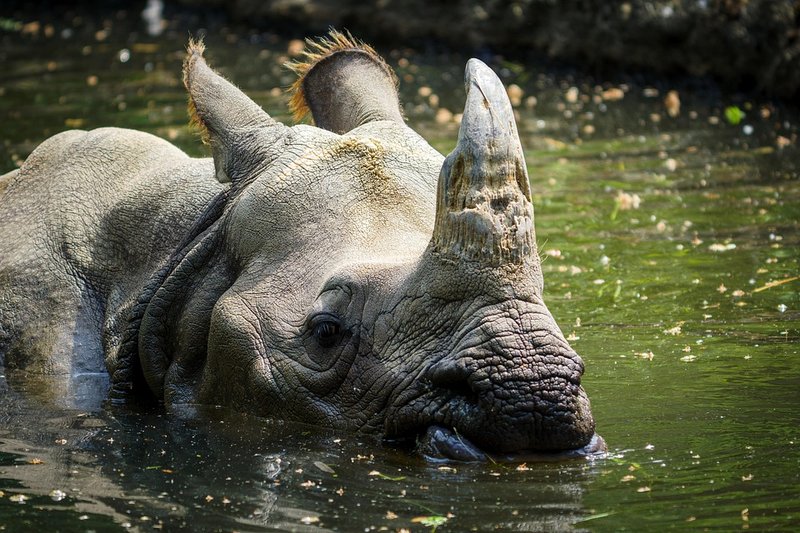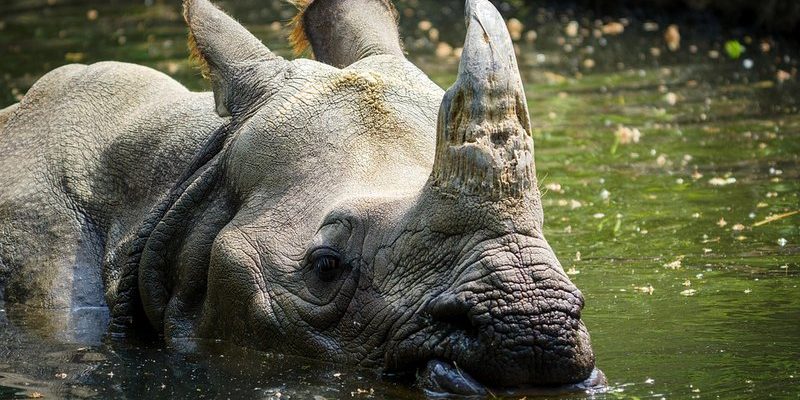
In this article, we’ll explore the unique features and behaviors that help Indian rhinoceroses not just survive but thrive in their environments. From their impressive physical adaptations to their social behaviors, we’ll uncover how these remarkable animals navigate a world full of challenges. So grab a cup of coffee and let’s dig into the world of the Indian rhino!
Physical Adaptations: Thick Skin and Size
One of the first things you’ll notice about Indian rhinoceroses is their thick skin. This isn’t just for show; it offers protection against harsh environmental elements and potential predators. The skin of an Indian rhino is about 2.5 centimeters thick, made up of layers of collagen that act like armor. Think of it as a built-in shield that allows them to roam freely in the grasslands without worrying too much about cuts or scrapes.
Moreover, their massive size—adult Indian rhinos can weigh up to 2,200 kilograms—acts as a deterrent to many potential threats. Predators like tigers or leopards prefer to hunt smaller, more vulnerable animals. With their sheer bulk, Indian rhinos can often intimidate would-be attackers.
However, it’s not all about size and skin. The structure of their bodies plays a vital role in their survival. Their wide mouths allow them to graze on tough grass and browse on shrubs, giving them access to a wide range of food sources even in tough conditions.
Thermoregulation: Staying Cool in the Heat
Living in warm climates can be a challenge, especially for large animals. But Indian rhinoceroses have some clever tricks up their sleeves for staying cool. Their skin does more than protect them; it also helps them regulate their body temperature. When the sun beats down, these rhinos often take a dip in rivers or mud pools. It’s not just for fun—mud acts as a natural sunscreen, protecting their skin from harmful UV rays and helping to keep them cool.
You might wonder, “How does mud help?” When they coat themselves in mud, it cools them down as the water evaporates. Plus, it also helps keep pesky insects at bay. Imagine applying a protective lotion that also gives you a refreshing chill—pretty neat, right?
Moreover, they have a natural tendency to be crepuscular, meaning they’re most active during the cooler parts of the day, like early morning and late evening. By avoiding the searing midday sun, they reduce heat stress and conserve energy, making their daily routines much more manageable.
Dietary Adaptations: Grazers in the Grasslands
When it comes to food, Indian rhinoceroses are primarily grazers. They feast on a variety of grasses, leaves, and shrubs, which are plentiful in their natural habitats. But surviving in harsh environments means being adaptable with their diet. During dry seasons when food is scarce, Indian rhinos can switch their diet to include more fibrous plants and even bark.
Their strong jaws and grinding teeth are designed to handle tough vegetation, allowing them to munch away at even the toughest of plants. Imagine having a built-in food processor in your mouth; that’s essentially what these animals have!
Interestingly, Indian rhinos also play a crucial role in their ecosystems. By grazing, they help to keep grasslands healthy and encourage new plant growth. This not only supports their survival but also benefits countless other species that share their habitat.
Social Structure and Behavior: Group Living
While Indian rhinoceroses might seem solitary, they are quite social creatures. They often gather in loose groups, especially females with calves. This social behavior provides several advantages—primarily safety in numbers. By staying close together, they can help keep an eye out for predators and alert one another if danger approaches.
You might be thinking, “But aren’t they mostly solitary?” That’s true for males, who tend to be more solitary as they grow older. However, the females and their young often form small groups. It’s a bit like having a supportive friend group; they look out for each other and share resources when times are tough.
Additionally, Indian rhinos communicate through a range of sounds, from grunts to trumpets. These vocalizations can indicate everything from distress to contentment, helping them maintain social bonds and navigate their relationships within the group.
Habitat Adaptation: Resilience in Diverse Environments
Indian rhinos are adaptable, able to thrive in a range of habitats. Their primary homes are the grasslands and forest edges of places like Kaziranga National Park in India, where they roam in search of food and water. However, they can also be found in slightly more challenging environments, like wetlands and riverine forests.
Their ability to adapt to different surroundings helps them endure changing conditions, whether it’s a dry spell or a heavy monsoon season. In response to seasonal changes, they may migrate short distances to find more favorable conditions, demonstrating remarkable resilience.
To put it simply, Indian rhinoceroses are like the ultimate survivalists. Imagine having the skill to navigate through varied terrains and climates with ease—that’s what they do every day.
Conservation Challenges: Threats from Humans
Despite these remarkable adaptations, Indian rhinoceroses face significant threats, primarily from human activities. Poaching remains a critical issue, as their horns are highly valued in illegal trade. Habitat loss due to agriculture and urbanization also severely limits their living space, making it harder for them to thrive.
Conservation efforts are ongoing, focusing on protecting their habitats and reducing poaching. Organizations work tirelessly to raise awareness and implement protective regulations, but challenges remain.
You might be wondering what you can do. Supporting conservation organizations, spreading awareness, and advocating for stronger protective measures are all vital steps we can take to ensure that Indian rhinoceroses continue to survive in harsh environments.
So, there you have it! Indian rhinoceroses are not just tough animals surviving against the odds; they are a testament to the power of adaptation and resilience. Through their unique physical traits, clever behaviors, and social structures, they navigate life in some of the harshest environments with grace. Understanding their challenges and supporting conservation efforts will help ensure that these incredible animals continue to roam the Earth for generations to come.
Next time you see a picture of an Indian rhino, remember the layers of adaptation that allow them to thrive. They’re not just big and bulky; they’re survivors in a world that demands strength and ingenuity.

